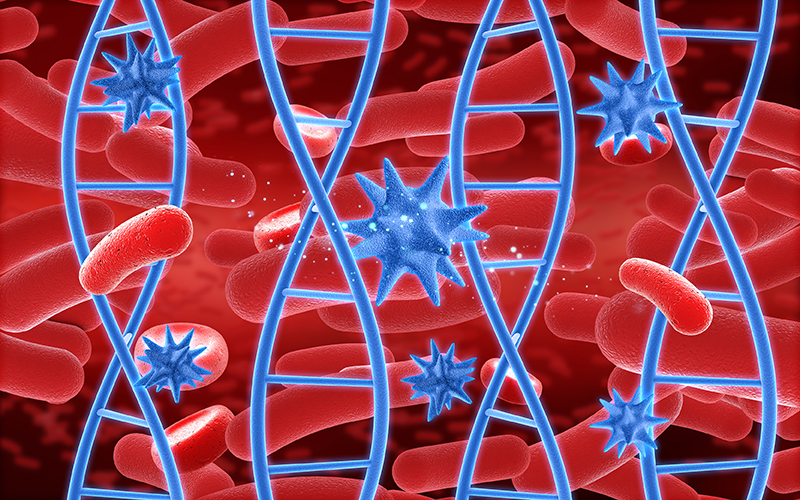The blood cells are produced in the hollow of the bone, in a soft gel like part called bone marrow. The cells produced are primitive ones called stem cells and these are pluripotent in nature. This mean they have the potential to develop into all types of blood cells. The process of the stem cells differentiating into different types is called hematopoiesis. The stem cells differentiate into two different cell groups- the myeloids and the lymphoids. The lymphoids are responsible for our immune system while myeloid group differentiate further to form red blood cells, white blood cells and platelets.

Leukemia, a type of blood cancer, is caused by rapid production of abnormal cells and the ability of the bone marrow to produce cells is impaired. The progression of leukemia is classified as acute or chronic. The acute type spreads very fast and requires immediate treatment whereas chronic spreads slowly and the treatment need not be immediate. Depending on the cell group affected and the progression of cancer, leukemia is of four main types:
- Acute Lymphocytic Leukemia (ALL)
- Acute Myelogenous Leukemia (AML)
- Chronic Lymphocytic Leukemia (CLL)
- Chronic Myelogenous Leukemia (CML)
What happens in Chronic Lymphocytic Leukemia:
CLL is a leukemia that affects the lymphoid cell group and the cancer progress slowly and is chronic. The lymphatic system is a system of vessels, tissues and organs that transport the lymph fluid, which contains infection fighting white blood cells. The lymphatic organs include thymus, spleen, tonsils, appendix along with lymphatic tissues present at a few other organs.
The cells of the lymphatic system, lymphocytes are of two types, B lymphocytes and T lymphocytes, also called B cells and T cells. B cells make antibodies to fight against germs and other foreign bodies and T cells destroy germs and other abnormal cells and catalyze the activity of other immune system cells.
In CLL, the lymphocytes start multiplying forming diseased lymphocytes and also crowding the bone marrow decreasing the production of other blood cells. The process is slow so symptoms are not observed immediately. Since the lymphocytes are responsible for the immunity of the body, the immune system is affected and the body becomes susceptible to a lot of other diseases and infections in addition to the growing cancer.
Risk factors:
Risk factors are the identified conditions that have higher probabilities of developing a disease. Presence of risk factor of blood cancer does not imply the presence of the disease, it only indicates that the chances might be higher. The following are the risk factors of chronic lymphoid leukemia.
- Age: The average age of patients with CLL is 71 years with over 90% of the cases being older than 50 years and it is rarely seen in young people.
- Gender: Though the exact reason is unknown, CLL is more common in men than in women.
- Family history: The people with first degree relations (siblings, parents and children) with CLL are two to four times more likely to develop this cancer than the people without a family history of the disease.
- Ethnicity: People of Asian descent are seen to be less likely to develop CLL than those of American or European descent.
Symptoms:
Chronic leukemias do not show any symptoms in the early stages, and the symptoms seen depend on the type and extent of the leukemia. The common symptoms include:
- enlarged lymph nodes but not usually painful
- Tiredness, fatigue or weakness
- Fever without any apparent cause
- night sweats or chills
- weight loss, loss of appetite
- frequent infections
- abdominal fullness due to swelling of the spleen
Staging:
Staging is crucial factor to decide the course of treatment of cancer. Usually blood cancers are staged on the basis of size of tumour and its spreading, but that approach does not work for leukemias as these are the cancers in the bone marrow and formation of cancerous tumour is rare for these. Different leukemias have different staging systems too. CLL has two staging systems- Rai and Binet, the former being more common in the US and the latter preferred in Europe.
Rai staging system:
This system divides the cancer into five stages and three factors determine the stage of CLL- whether or not the lymph nodes, spleen etc are enlarged, the total number of lymphocytes in the blood and if anemia or other disorder is present. The stages are Rai Stage 0 to Rai Stage IV.
Binet staging system:
This system differs from the one above as it takes into account how many types of lymphoid tissues are affected. The stages are commonly called clinical stages:
- Clinical stage A
- Clinical stage B
- Clinical stage C
Stage A is marked by less than 3 organs affected by CLL, Stage B more than three organs affected and Stage C is marked by presence of anemia and/or thrombocytopenia.
Diagnosis:
The following tests may be used to diagnose chronic lymphocytic leukemia.
- Blood tests: The count of red blood cells and platelets falls in CLL and the conditions are called anemia and thrombocytopenia respectively.
- Flow cytometry for immunophenotyping: This is one of the tests that can confirm or deny the cancer. This method uses chemicals and dyes that react to the surface proteins to give distinct markers.
- Bone marrow biopsy or aspiration involves removing the bone marrow sample by injecting a thin needle and this test can reveal the presence of cancerous cells in the bone marrow.
- Imaging tests: Imaging tests like X ray, CT scan or ultrasound can detect the spreading of cancer to other parts of the body.
Treatment:
The treatment method for CLL depends on the patient’s age, response to treatment and the major symptoms. CLL is difficult to cure and early treatment is not known to increase the patient’s longevity. This combined with the potential side effects of cancer treatments to worsen the situation, doctors often start the treatment for CLL after the disease progresses.
Chemotherapy is done if the patient can tolerate the side effects, monoclonal antibodies, radiation therapy, stem cell transplant are the other treatment methods employed singly, or as a combination depending on the case.
Survival rates:
Chronic Lymphocytic Leukemia has one of the highest survival rates, with the five year survival rate around 83%. The five year rate is a common measure that indicates how many patients live more than 5 years after diagnosis for every 100 cases. Like most other blood cancers, the patients don’t respond too well to treatment as the age increases. For CLL, the five year rate drops to less than 70% for patients over 75 years.



